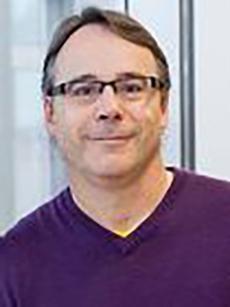Dr. Andrew Bendall

Captivated by natural history from an early age, my professional interest in biology was first kindled as an undergraduate in Australia's bush capital, taking upper level courses in biochemistry, molecular biology, and zoology. An early grounding in molecular biology followed as an honours student at the John Curtin School of Medical Research at the ANU. My Ph.D. training at the CSIRO Laboratory of Biomolecular Engineering in Sydney, was in the transcriptional control of eukaryotic gene expression, with emphasis on the DNA binding specificity of mammalian transcription factors. I then moved to the United States where I applied my knowledge of gene regulatory mechanisms to the developing vertebrate embryo. With a postdoctoral award from the American Heart Association, I developed strategies for misexpression of regulatory genes in the chicken embryo as an invivo model system in which to study the regulation of gene expression, cell differentiation, and tissue patterning during vertebrate embryogenesis. My laboratory continues to use this experimental strategy, among others, to investigate the molecular mechanisms of animal development.
- B.Sc. Australian National University
- Ph.D. Macquarie University (Sydney)
Homeobox genes encode a large and vitally important family of embryonically expressed transcription factors that regulate the essential processes of development. We are currently investigating the Dlx gene family during chick and mouse development. Unravelling the functions and mechanisms of action of this multi-member homeobox family promises to reveal larger truths about the cell-type specificity of protein function, the nature of functional redundancy, the acquisition of novel protein functions, and the evolution of animal bodies.
The chicken embryo has a distinguished history in developmental biology as a model vertebrate organism for the ability of investigators to manipulate embryonic tissues and, more recently, levels of gene activity. For us, the chicken embryo holds a central position in our attempts to decipher the mechanisms that regulate gene expression, cell fate, and morphogenesis. We combine in vivo experiments like retroviral-mediated transgenesis in chicken embryos with in vitro and cellular studies that, together, define the biochemical basis for biological functions. These studies are often complemented with molecular genetic approaches in the mouse.
Current projects include:
- Defining the function of Dlx genes in chondrocyte differentiation
- Investigating Dlx-mediated craniofacial patterning
- Identifying novel Dlx co-factors
- Structure-function analyses of Dlx-mediated transcription
- MacKenzie, R.K., Ravi Sankar, P. & Bendall, A.J. (2019) Dlx5 and Dlx6 can antagonize cell division at the G1/S checkpoint. BMC Mol. Cell Biol. 20:8, doi.org/10.1186/s12860-019-0191-6
- Quach, A. MacKenzie, R.K. & Bendall, A.J. (2016) Measuring inputs to a common function: The case of Dlx5 and Dlx6. Biochem. Biophys. Res. Comm. 478: 371-377
- Bendall, A.J. (2016) Direct evidence of allele equivalency at the Dlx5/6 locus. Genesis 54(5): 272-276
- Haq, K., Wootton, S., Barjeste, N., Golovan, S., Bendall, A.J. & Sharif, S. (2015) Studying the effects of interferon-gamma knockdown on vaccine-induced immunity against Marek’s disease in chickens. Can. J. Vet. Res. 79(1): 1-7
- Haq, K., Wootton, S., Barjeste, N., St. Paul, M., Golovan, S., Bendall, A.J. & Sharif, S. (2013) Small interfering RNA-mediated knockdown of chicken interferon-gamma expression. J. Interferon Cytokine Res. 33(6): 319-327
- Hawley, S.P, Wills, M.K.B., Rabalski, A.J., Bendall, A.J. & Jones, N. (2011) Expression patterns of ShcD and Shc family adaptor proteins during mouse embryonic development. Dev. Dyn. 240(1): 221-231
- Gordon, C.T., Brinas, I.M.L., Rodda, F.A., Bendall, A.J., & Farlie, P.G. (2010) Role of Dlx genes in craniofacial morphogenesis: Dlx2 influences skeletal patterning by inducing ectomesenchymal aggregation in ovo. Evol. Develop. 12(5): 459-473
- Zhu, H. & Bendall, A.J. (2009) Dlx5 is a cell-autonomous regulator of chondrocyte hypertrophy in mice and functionally substitutes for Dlx6 during endochondral ossification. PLoS ONE 4(11): e8097
- Coubrough, M.L. & Bendall, A.J. (2006) Impaired nuclear import of mammalian Dlx4 proteins as a consequence of rapid sequence divergence. Exp. Cell Res. 312(19):3880-3891
- Hsu, S-h.C., Noamani, B., Abernethy, D.E., Zhu, H., Levi, G., & Bendall, A.J. (2006) Dlx5- and Dlx6-mediated chondrogenesis: differential domain requirements for a conserved function. Mech. Dev. 123(11): 819-830
I have had a long-standing involvement with the teaching of first year biology, including the development and delivery of the new Introduction to Molecular and Cellular Biology (BIOL1090). I also teach the senior level Genetics and Molecular Biology of Development (MBG*4040/4070). At any given time I also have one or two undergraduate students studying and training in my laboratory in the fourth year Molecular and Cellular Biology projects course (MCB*4500/4510). To date, four of these students have elected to stay on with my group as graduate students.
At the graduate level, I have been an instructor and coordinator for the advanced topics course, now called MCB*6310 Advanced Topics in Molecular and Cellular Biology.
- Afshan Sohail (Ph.D. student)